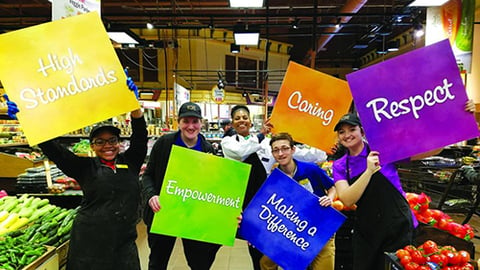Workforce 2020: A Sneak Peek at the Future of Labor in the Grocery Industry
If you want to know the state of workforce management and productivity in the food retail industry, just look at what the nation’s No. 1 seller of groceries is doing.
Over the past year, Walmart Inc. has flooded its stores with robots that mop floors and stock shelves. The mega-retailer has also ramped up workers’ benefits to include expanded medical care, free college, innovative management training programs and a pledge to pay most of its hourly associates at least $15 an hour — some workers will earn much more — by the end of this year.
Survey Sponsored By:
Key Takeaways
- Grocers must take steps to empower their associates to make significant business decisions that could have a bigger impact on the bottom line.
- Among the workforce challenges that food retailers will need to grapple with in 2020 and beyond are recruitment, retention, training, diversity and inclusion.
- Another key factor driving workforce transformation is a decrease in the number of physical store jobs as the nature of work is redefined by technology; however, this decrease will be offset by growth in jobs in delivery, customer service, technology and fulfillment.
“We believe this is the key to winning the future of retail,” says Drew Holler, SVP of associate experience at Bentonville, Ark.-based Walmart. “There are many examples where we are seeing the power of our associates’ creativity and how that’s helping our customers. These aren’t always stories that make headlines, but they add up to a big impact.”
“The power of creativity” is surely one way to define (redefine?) America’s food retail workforce in 2020.
Nearly 5 million people are employed in retail jobs, and almost 3 million of those people work in grocery stores. Many of these jobs still involve old-fashioned tasks in physical stores, but the reality is that today’s food retail industry is a collage of full-time employees, gig workers and artificial intelligence performing an ever-widening range of tasks.
When Kroger hired workers in 2010 for retail jobs, those workers might be expected to operate cash registers, clean bathrooms or slice turkey in the deli. As we enter a new decade, those same workers might be expected to troubleshoot shipping delays for online orders, load groceries into car trunks in the middle of a snowstorm, earn five-star Google reviews for good customer service, deliver pizzas to shoppers’ homes, or even grill a perfect porterhouse steak for a diner in a store restaurant.
Meanwhile, unemployment is at a 50-year low, and many of the (younger) workers who are ideal candidates for these tech-oriented, multifaceted jobs are as demanding as the new generations of shoppers crowding grocery stores with requests for one-hour delivery of hot vegan chili. All of this amounts to a tidal wave of workforce challenges for food retailers that must be overcome in 2020 and beyond.
So what can grocers and other food retailers do as they head into this labor maelstrom? Of course, implementing the latest in-store technologies and optimizing selling channels are good places to start, but there’s an important opportunity that shouldn’t be missed: empowering workers — many of whom will be Zoomers, or Generation Z — to deliver a superior food shopping experience that puts your brand above the competition. Grocers must take steps to empower their staffs to make bigger business decisions that could have a bigger impact on the bottom line.
Here’s a look at the workforce challenges that food retailers will need to overcome in 2020 and beyond:
Recruitment
In a tight labor market in which wages are rising, food retailers have an especially acute challenge when it comes to hiring the right talent for increasingly tech-heavy jobs. Employees today must have a solid understanding of both digital and physical retail, and be able to deploy the latest tools to propel their company forward.
“You have to be very smart about how you deploy labor in the future,” says Stew Leonard Jr., president and CEO of Norwalk, Conn.-based Stew Leonard’s. “Especially at $15 an hour. We’ve got some new technology that’s going to really help us try to match the sales in the store with the labor hours. What we want to do is make sure we have the right number of people at the right times to help the customer.”
Grocers increasingly recognize that in this labor market, offering flexibility around scheduling and hours is one strategic way to attract workers without increasing wages. More retailers will adopt staffing technologies and platforms, as Stew Leonard’s is doing, to provide the flexibility workers want and to improve efficiencies across the business.
Data from Chicago-based on-demand staffing technology platform Bluecrew indicates that workers favor flexibility above all other aspects of the job, even pay and perks. A Bluecrew analysis of more than 10,000 job offer rejections found that a quarter (26%) of jobs were rejected due to the hours offered, compared with 10% of jobs rejected due to pay.
How retailers recruit the right talent is going to be more important than ever in 2020. Food retailers are going to have to modify their job descriptions to highlight flexible scheduling, in addition to protections and benefits also being offered by competitors and gig companies.
Retention
“Food retail is an industry that tends to have turnover rates on average multiples of times ahead of the rest of the country,” says Matt Zender, workers’ compensation VP at New York-based AmTrust Financial Services. “Some retailers are taking creative approaches to their package, whether it’s in wages or other benefits, as they try to attract a higher quality of candidate, but also as they try to entice employees to stay, to lower their turnover rate.”
The increase in competing jobs that offer both flexibility and worker protections will also be influenced by state regulations such as California’s AB5, which went into effect on Jan. 1. According to the San Francisco Chronicle, AB5 makes it harder for companies to claim workers are independent contractors. The law says that workers should be employees unless a) they are free from a company’s control, b) do work outside the company’s core business, and c) have independent enterprises performing the same type of work.
“Some of the asks from prospective employees are unreasonable,” Zender notes, “but retailers should be trying to create an environment for employees that will cause them to feel better about where they’re working. I think retailers are now realizing that they might need to foster a workplace that’s going to cause people to feel excited about where they’re working at.”
Training
To attract and retain more talent and a better caliber of employee, food retailers are going to have to take new approaches to training and development. Some companies, such as Walmart and Kroger, are investing in upskilling programs for existing employees across the organization, whether they work in stores, offices or a warehouse.
-
Walmart specifically is emphasizing upskilling and career growth opportunities as key strategies for retention of its workforce, including:
- The launch of Walmart Academies, an immersive training program tied to a working supercenter, allowing associates to receive both classroom and sales floor training in advanced retail skills and soft skills like leadership, communications and change management. In 2018 alone, Walmart trained 450,000 associates, including frontline supervisors, department managers and assistant managers in these academies
- The creation of a new video game called Spark City that allows employees to role play as a department manager. Through the game, associates enrolled in Walmart Academies learn the same techniques and processes that they would use on the sales floor in real life
- In partnership with Guild Education, Walmart’s Live Better U program is giving associates the opportunity to earn debt-free degrees in business or supply chain management for just $1 per day. Walmart covers remaining costs and other required fees
- Associates are receiving college credit for paid training at Walmart Academies. As of 2019, associates had already earned more than $317 million in college credits
- The mega-retailer is also offering education benefits for GED, high school completion, language training and professional development
- In Walmart’s fiscal 2019, the company promoted more than 215,000 people to higher-paying jobs with increased responsibility
- Full- and part-time associates are eligible for quarterly bonuses based on store performance. In Walmart’s fiscal 2019, hourly associates earned nearly $800 million in bonuses
Other key training and retention trends that food retailers can expect in 2020 include the growth of upskilling for jobs in foodservice, distribution, delivery and logistics. As food retailers continue to invest heavily in machine learning and automation, opportunities for upskilling will only increase. This is a great strategy for retaining workers who are hungry for career advancement.
Diversity
Trying to appeal to a younger, more diverse demographic is no longer a matter of if, but how. The youngest generation in the United States — those born after 1996 — is the country's most racially and ethnically diverse generation, and is on its way to becoming the best-educated generation yet, according to data from the Washington, D.C.-based Pew Research Center. Nearly half — 48% — of Zoomers come from communities of color.
Diversity and inclusion must become bigger strategic imperatives in the food retail industry, because having a diverse workforce offers the advantage of evaluating business problems and opportunities from multiple perspectives. Retailers that leverage this opportunity will also have a more thorough understanding of their consumer base.
With nearly half the members of Gen Z identifying as a racial or ethnic minority, organizations that prioritize diversity and inclusion initiatives will have a huge leg up in recruiting and retaining the next-generation workforce.
At the same time, women are making some leadership gains in retail. Today, retail has the highest representation of women in the top job of CEO among large sectors in the Russell 3000: About 7% of retail CEOs are women, versus about 5% in the broader index. Many of these gains aren’t being felt in the more male-dominated world of grocery, however. Food retailers must do a better job of carving a path to leadership for women by empowering them in their organizations and across the industry to drive female leadership toward parity.
Other key factors driving workforce transformation in food retailing in 2020 and beyond include a decrease in the number of physical store positions as the nature of work is redefined by technology, including artificial intelligence, machine learning, virtual reality and robotics. However, this decrease will be offset by growth in jobs across the sectors of delivery, customer service, logistics and technology.
“As unemployment rates stay low, there are other areas that can help retailers drive growth, in the form of automation and tools and other resources that can help their workers work more effectively,” Zender says. “But if retailers are not thinking about their business in a manner that’s a little different, that takes advantage of technology and other tools and resources, they certainly should be.”










